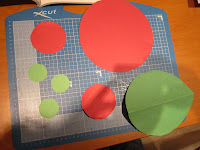First we learned that the amount of snowfall looks more than it actually is, because snow contains trapped air. Tiger filled a glass with the top layer of snow, before levelling the top off with a ruler.
We started the experiment with a cup full of fluffy snow.
 |
| At the start of the experiment. |
 |
| 45 minutes later. |
 |
| 90 minutes later. |
We also did a quick, low-tech review of the different states of matter and the corresponding processes that occur to make the changes, with Tiger giving me examples of materials in each state.
The next experiment is to demonstrate the difference in rate of fall between a snowflake and a raindrop using two balloons -- one inflated, the other not. Tiger dropped them at the same height, then explained what caused the difference in rate of fall, which he thought was due to different air pressure caused by different amount of air contained within each balloon.
I thought he might have a point there, but the explanation given in the book we use says that the difference is due to different surface areas exposed to friction in the air.
The movement of snowflakes in the air and other interesting points about how snowflakes are formed can be found in the following clip:
No study of snowflakes is complete without mentioning Snowlake Bentley. We had read the book before when Tiger was in his preschool years, but now we are relooking at it again to recap:
We also watched a short film about him:
I dug out a set of snow crystal prints that I had printed off and laminated into cards years ago. We admired the intricacies of each snowflake and noted certain mathematical characteristics: symmetry, hexagonal patterns.
We then attempted to cut out some paper snowflakes with the same hexagonal patterns. To make the folding easier, we decided to cut out circles first. It took Tiger a while to get used to handling the mathematical compass to draw different sized circles on the coloured papers:
The folding and cutting were quite simple, once Tiger figured out the instructions to fold the circle into sixths.
We played with the online interactive Make-A-Flake game for a while but decided that we prefer to cut real papers.
This post is linked up to:
1) Enchanted Thursdays Blog Hop #40
2) Homeschool Mother's Journal: December 7, 2012
3) Collage Friday
4) It's a Wrap
5) TGIF Linky Party #57
6) Weekly Wrap-Up: The Busy One
7) Sunday Showcase
8) Science Sunday
9) Christmas Science
10) All Year Round Blog Carnival: Winter

















We have been having fun reading about snow! We have been learning about how the Eskimos have different names for the different types of snow they have. I find it fascinating.
ReplyDeleteI've heard about Eskimos having different names for different types of snow as well. Thank you for the reminder, Phyllis! We'll have to look that up as well.
ReplyDeleteI love the snow crystal prints - what a great idea for math! I sure wish we had snow around here!
ReplyDeleteWe love Snowflake Bentley! His photographs are SO beautiful and amazing! Every winter we have Snow Day and make paper snowflake, snow ice cream, read the book and look at photographs, paint snow pictures. So far we've only gotten a dusting of snow a couple of times, but I'm sure we'll have FEET in another month.
ReplyDeleteWe are planning a snowflake study in January. Thanks for some great ideas to add to my plan!
ReplyDeleteMan! This makes me wish we had some snow as well! We're *supposed* to have snow. Buckets of snow, in fact, is the norm. But I looked at my yard the other day and wondered if we ought to mow. Hopefully we'll get some snow soon and be able to do some of these fun activities!
ReplyDeleteI don't envy you the snow, but it does look like it made for some fun experimenting. I love Janice Van Cleave. :-)
ReplyDeleteWhat a wonderful science lesson on snow (I wish we had more snow). I have pinned this science lesson to try to tie in with our Winter unit in January. Thank you for linking up this week to my Enchanted Thursdays Blog Hop!
ReplyDeleteMy twins are too young to learn the science right now, but it reminded me that we can make some of our own paper snowflakes. Thanks for this reminder!
ReplyDeleteLove the snow experiment! I bet if we had snow my daughter will love to do this. ;)
ReplyDeleteThese are great ideas for winter activities! We've never really studied snow much. I think it might be a nice change of pace January or February. Thanks for sharing! :)
ReplyDeleteWhat a fun unit. I wish it snowed here!
ReplyDeleteThanks so much for the idea! My boys will love to do this over Christmas break.
ReplyDeleteCathy from www.thecurriculumcorner.com
My girls love making paper snowflakes and we've never made them using different color paper. Just white. Boring... :) Thanks for the great science project and ideas!
ReplyDeleteawesome!Please feel free to link this or any math or science related ideas to my Christmas link up. I am trying to collect great ideas like yours in one place
ReplyDeletehttp://piwiprincess.blogspot.com/2012/12/language-math-and-history-became-our.html
I love this experiment. Thanks for linking up to its a wrap. You might also consider adding this to Look What We Did. As a matter of fact many of your posts would fit nicely there. lookwhatwedid-homeschool.blogspot.com
ReplyDeleteWhat a great snow lesson! I love that first experiment, I hadn't thought about doing that.
ReplyDeleteWe RARELY get snow here either.
Thanks for linking up to Science Sunday!
Nice ideas and sharing. Gonna share this one on my social media. Thanks!
ReplyDelete